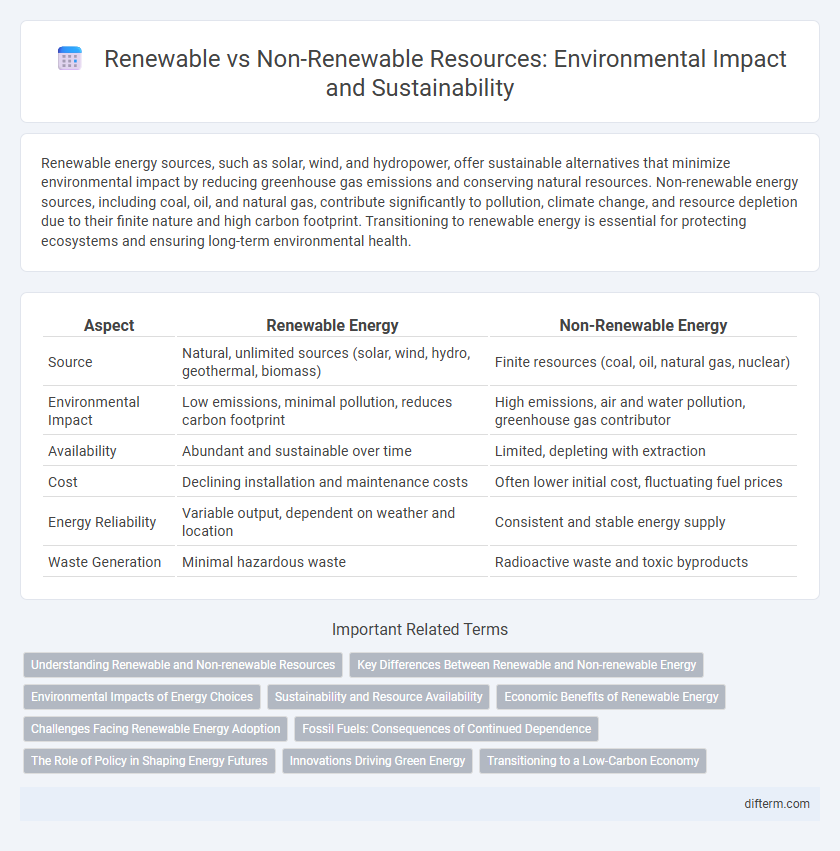Renewable energy sources, such as solar, wind, and hydropower, offer sustainable alternatives that minimize environmental impact by reducing greenhouse gas emissions and conserving natural resources. Non-renewable energy sources, including coal, oil, and natural gas, contribute significantly to pollution, climate change, and resource depletion due to their finite nature and high carbon footprint. Transitioning to renewable energy is essential for protecting ecosystems and ensuring long-term environmental health.
Table of Comparison
| Aspect | Renewable Energy | Non-Renewable Energy |
|---|---|---|
| Source | Natural, unlimited sources (solar, wind, hydro, geothermal, biomass) | Finite resources (coal, oil, natural gas, nuclear) |
| Environmental Impact | Low emissions, minimal pollution, reduces carbon footprint | High emissions, air and water pollution, greenhouse gas contributor |
| Availability | Abundant and sustainable over time | Limited, depleting with extraction |
| Cost | Declining installation and maintenance costs | Often lower initial cost, fluctuating fuel prices |
| Energy Reliability | Variable output, dependent on weather and location | Consistent and stable energy supply |
| Waste Generation | Minimal hazardous waste | Radioactive waste and toxic byproducts |
Understanding Renewable and Non-renewable Resources
Renewable resources, such as solar energy, wind, and biomass, are abundant and naturally replenished within a human lifespan, making them sustainable energy sources. Non-renewable resources, including coal, oil, and natural gas, exist in finite quantities and deplete over time, contributing significantly to environmental pollution and greenhouse gas emissions. Understanding the distinction between these resources is critical for developing sustainable energy policies and mitigating climate change impacts.
Key Differences Between Renewable and Non-renewable Energy
Renewable energy sources, such as solar, wind, and hydro, are naturally replenished and sustainable, producing minimal greenhouse gas emissions compared to non-renewable sources like coal, oil, and natural gas, which are finite and contribute significantly to environmental pollution and climate change. Renewable energy systems help reduce dependence on fossil fuels, promote energy security, and support long-term ecological balance. Non-renewable energy extraction and consumption lead to resource depletion, habitat destruction, and increased carbon footprint, intensifying global warming concerns.
Environmental Impacts of Energy Choices
Renewable energy sources such as solar, wind, and hydroelectric power significantly reduce greenhouse gas emissions compared to fossil fuels, mitigating climate change and air pollution. Non-renewable energy sources like coal, oil, and natural gas contribute to habitat destruction, water contamination, and increased carbon dioxide levels, exacerbating global warming. Transitioning to renewable energy minimizes environmental degradation while promoting sustainable resource use and long-term ecological balance.
Sustainability and Resource Availability
Renewable energy sources such as solar, wind, and hydro provide sustainable power with minimal environmental impact, ensuring long-term resource availability. Non-renewable resources like coal, oil, and natural gas face depletion risks, contributing to environmental degradation and climate change. Investing in renewable technologies promotes energy security and reduces carbon emissions, supporting global sustainability goals.
Economic Benefits of Renewable Energy
Renewable energy sources such as solar, wind, and hydropower stimulate economic growth by creating millions of jobs in manufacturing, installation, and maintenance sectors globally. Investments in renewable infrastructure often yield long-term cost savings due to lower operational expenses and reduced reliance on volatile fossil fuel markets. Furthermore, renewable energy adoption mitigates environmental degradation, decreasing healthcare costs associated with pollution and enhancing overall economic resilience.
Challenges Facing Renewable Energy Adoption
Renewable energy adoption faces challenges such as high initial investment costs, intermittency issues, and inadequate energy storage technologies. Infrastructure limitations and grid integration complexities hinder the seamless transition from non-renewable to renewable sources. Policy inconsistencies and lack of incentives further slow down large-scale implementation of solar, wind, and other sustainable energy solutions.
Fossil Fuels: Consequences of Continued Dependence
Continued dependence on fossil fuels accelerates climate change through increased greenhouse gas emissions, leading to more frequent extreme weather events and rising global temperatures. Fossil fuel extraction and consumption also result in environmental degradation, including air and water pollution, habitat destruction, and health hazards for communities. Transitioning to renewable energy sources is essential to mitigate these consequences and promote sustainable environmental stewardship.
The Role of Policy in Shaping Energy Futures
Effective energy policies drive the transition from non-renewable fossil fuels like coal and oil toward renewable sources such as solar, wind, and hydroelectric power by incentivizing clean energy investments and penalizing carbon emissions. Regulatory frameworks including carbon pricing, subsidies for green technologies, and mandates for renewable energy adoption are pivotal in accelerating decarbonization efforts and achieving climate goals. Policy decisions impacting infrastructure development and energy market reforms ultimately shape sustainable energy futures, balancing economic growth with environmental protection.
Innovations Driving Green Energy
Advancements in solar photovoltaic technology and wind turbine efficiency are revolutionizing renewable energy capacity, significantly reducing reliance on fossil fuels. Innovations such as energy storage systems, including lithium-ion and solid-state batteries, enhance grid stability and enable continuous green energy supply. Breakthroughs in bioenergy and hydrogen fuel cells further diversify the clean energy portfolio, accelerating the transition from non-renewable resources.
Transitioning to a Low-Carbon Economy
Transitioning to a low-carbon economy hinges on shifting energy production from non-renewable sources such as coal, oil, and natural gas to renewable alternatives like solar, wind, and hydroelectric power. Increasing investment in renewable technologies reduces greenhouse gas emissions, mitigating climate change and enhancing energy security. Policies promoting energy efficiency and clean energy infrastructure accelerate the decarbonization process, fostering sustainable economic growth.
Renewable vs Non-renewable Infographic

 difterm.com
difterm.com